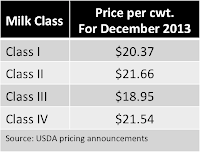Protein payment made up 56% of the value of December Class III milk, but this was down from the prior month. The prior month payment for milk protein made up 68% of the milk check which was a record. The higher price for butter has increased the payment for butterfat while decreasing the payment for milk protein.
Inventory data for December is not yet available but an analysis of inventories and exports will soon be posted to this blog.
Nonfat Dry Milk
The price of nonfat dry milk is not typically a discussion point for those paid on components. Nonfat dry milk pricing does not affect the Class III price in any way. However, it does impact the payment to producers paid on the Class III component basis, which is the majority of U.S. dairy producers. This apparent contradiction is explained below.
Nonfat dry milk is the basis of the Class IV milk price.
Class IV Skim Milk Price = Nonfat Solids Price x 9
Nonfat solids pricing is calculated from the nonfat dry milk price as shown below.
Nonfat Solids Price = (Nonfat Dry Milk - 0.1678) x 0.99
As reported in a prior post to this blog, strong exports of nonfat dry milk and the international value of nonfat dry milk have created an environment which is setting a five year high for U.S. nonfat dry milk prices. The pricing of nonfat dry milk is shown below. Over the last four years, pricing has nearly doubled.
Therefore Class IV milk prices are also setting records. Starting in February 2013, the Class IV price of milk has been higher than the Class III price. The difference between the Class III price and the Class IV price continues to increase and is currently $2.59/cwt.
Base Skim Milk Price for Class I = Higher of Advanced Class III or IV Skim Milk Pricing
The Class II Skim Milk price is always determined by the Advanced Class IV price.
Class II Skim Milk Price = Advanced Class IV Skim Milk Pricing + $.70
The bottom line impact is that the nonfat dry milk price is now driving the Class I, II, and IV milk prices. For the month of December, the comparative prices for Class I, II, III, and IV are as shown in the table below.
The price of Class IV milk is currently higher than Class I and Class III milk and close to the Class II price. This is a drastic change from the norm. The same Class pricing for December 2012 is shown below for comparison.
The December 2012 pricing is more typical with Class IV milk as the lowest paid Class. A
strong export market with good pricing drives the current situation.
How does this impact the majority of U.S. producers who are paid on the component system? The Producer Price Differential is based on a comparison of the Class III price to the weighted average of all classes. Therefore, the Producer Price Differential will be higher because the Class III price is currently the lowest paid. And because of this, there will be less de-pooling of milk especially in the Upper Midwest.
Inventory data will be reviewed in an upcoming blog post when the data is available.








No comments:
Post a Comment